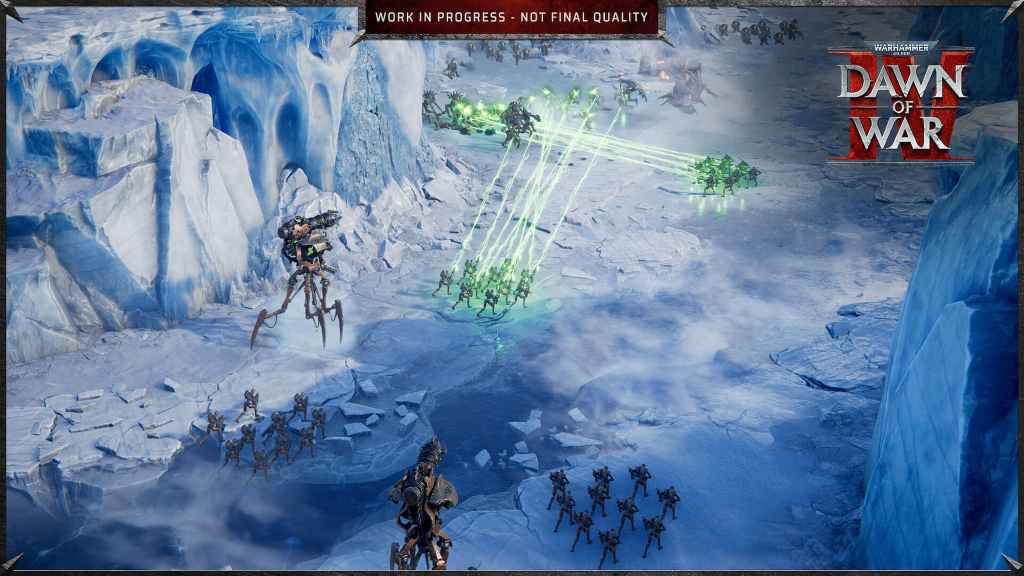
After the release of Warhammer 40,000: Dawn of War Remastered, the official reveal of Warhammer 40,000: Dawn of War 4 happened at Gamescom Opening Night Live. It is being developed by KING Art, the team behind Iron Harvest, and published by Deep Silver. This marks a long-awaited return to the series, and fans couldn’t be more excited. The reveal trailer gave a short look at gameplay, the story, and some of the factions available in the game. However, while many fans are excited for Dawn of War 4, there is some trepidation as the reception to each game in the series has been different.
There is no doubt that Warhammer 40,000: Dawn of War is the best game in the series, and possibly one of the best RTS games of all time. It received several expansions, bringing its selection of factions to nine. Not only that, but its campaign and multiplayer were almost universally loved. All of this culminates in the future that fans want from Warhammer 40K: Dawn of War 4.
Warhammer 40,000: Dawn of War 2 & 3 Made Mistakes

Warhammer 40,000: Dawn of War 2 and Dawn of War 3 expanded on the series, but both went in different directions than fans would have liked. While the initial look at Warhammer 40K: Dawn of War 4 seems promising, it is already risking repeating mistakes that led to the downfall of the series.
One of the biggest causes for concern is the number of factions in Dawn of War 4. Shown at Gamescom were only four factions, and this doesn’t even include classic ones like the Eldar and Chaos. Even weirder is the choice of the Adeptus Mechanicus. While it is great to see the faction getting more attention, including them in a game with only four factions when the Space Marines are already available seems odd. Previous games have launched with four factions, but one would expect a revival of the series to go all out.
Gameplay seems to have a mixed reception among fans. At first glance, it appears to return to the base-building big firefights of Dawn of War. But it also seems to borrow ideas from Dawn of War 2 and Dawn of War 3. Unit Cards, similar to the ones in the Total War series, were spotted during the gameplay, which has fans worried.
This seems to indicate that there may be predetermined units and squads that players can pick from. Dawn of War 2 deviated from the first game in this regard, severely limiting the scale of battle and tactical options. While base-building is back, fans want the ability to completely customize their army and change up their strategy freely. Dawn of War 2 implemented weird MOBA mechanics that did not flow with the series, and it suffered because of this.
Dawn of War 3 largely removed these MOBA elements, but made even more baffling choices for the series. It focused on giant units and elite heroes while implementing a half-baked version of base-building. It even launched with a smaller faction than Dawn of War 2, limiting the game and making its focus on special units lackluster. This doesn’t even touch on the game’s poor writing.
Warhammer 40,000: Dawn of War 4 Shows a Promising Start

Little was seen of Warhammer 40K: Dawn of War 4’s gameplay. Initial receptions were mixed, but several elements stood out. The first is the story, seeing a return to Kronus and the Necrons being a prominent enemy. What was confusing was seeing Cyrus, a sergeant of the Blood Ravens, killed during the cinematic, but then available later as a unit in a match.
Building is back, and it looked as if sync kills have also made a return. This, combined with the return of base-building, is promising, but KING Art needs to learn from Dawn of War and not the abomination that was Dawn of War 3’s attempt at base-building. There is more hope for this, as many of the mechanics from Dawn of War can be seen on screen, such as energy, population, and more.
The battles seem to be more large-scale, which is in line with the first game and will lead to epic skirmishes like those in Warhammer 40,000: Space Marine 2. But this was hindered because fans were mixed on the camera angle. It looks as if KING Art is aiming to recreate how it feels to play the tabletop version of Warhammer 40,000, but this is very different from previous games. This isn’t a bad thing necessarily, and can lead to a more immersive experience.
It remains to be seen what the full experience will be. An army painter, the return of a cover system, and skirmish are all promising editions to the game. Dawn of War 4 has also confirmed John French, the legendary Black Library author, is joining the game as a co-writer. This has reassured fans as far as the story goes, hopefully avoiding one of Dawn of War 3’s major pitfalls.
Warhammer 40,000: Dawn of 4 is scheduled for release in 2026, meaning there is still a lot of time left for development. There is no doubt KING Art is looking at the initial feedback from this reveal trailer and will take this into consideration throughout development. Dawn of 4 has the potential to be the series’s best game yet, but it needs to learn from its predecessors, both what to do and what not to do.
The post Warhammer’s Dawn of War 4 Looks Promising, But It Needs to Distance Itself From DOW 2 & 3 appeared first on ComicBook.com.

